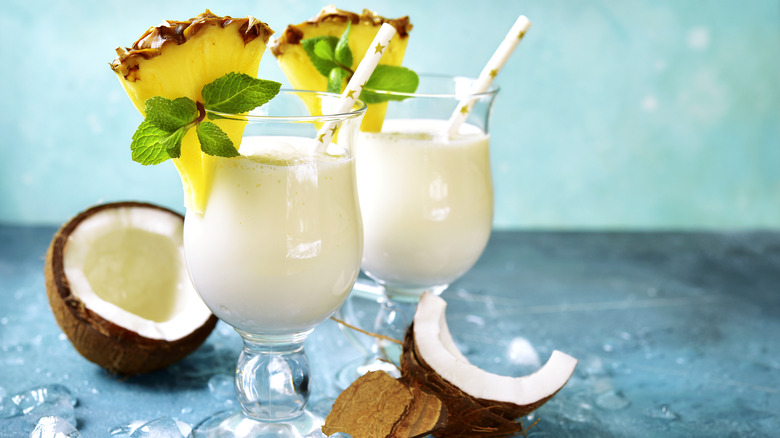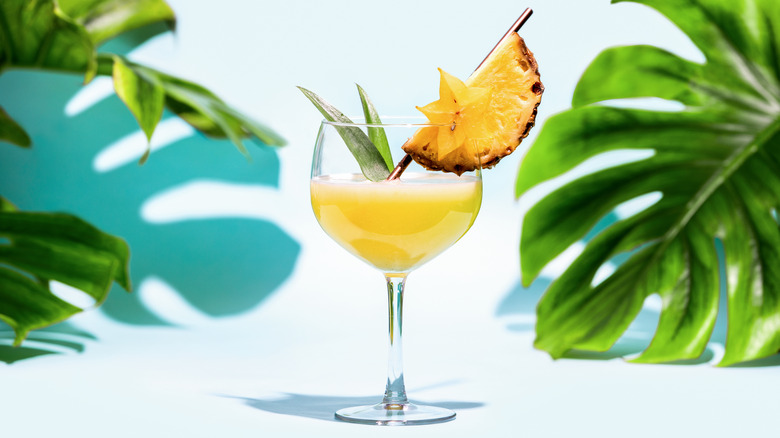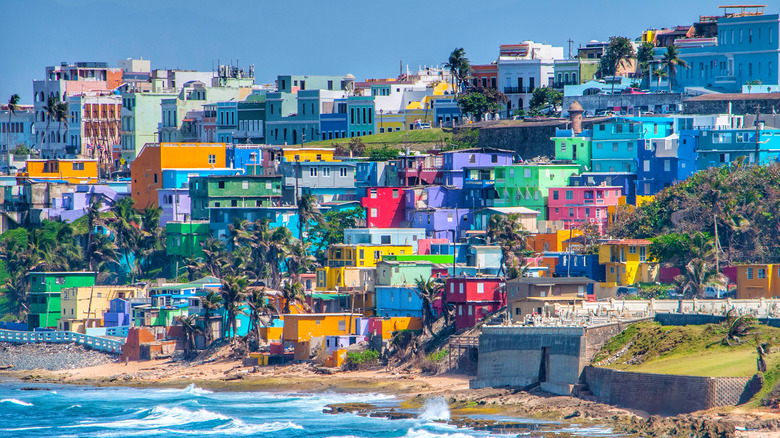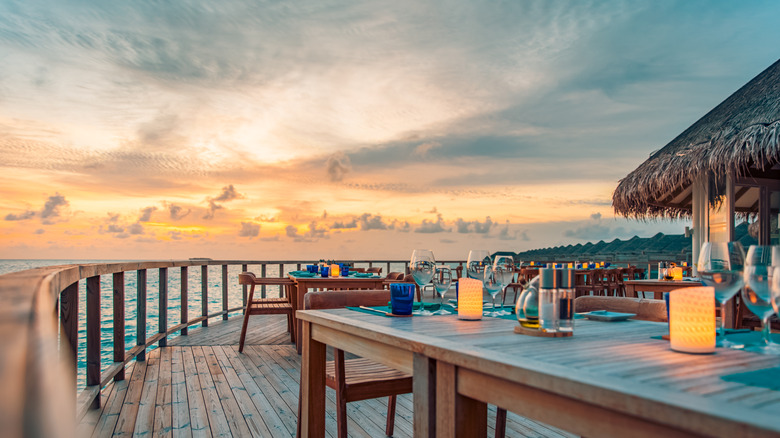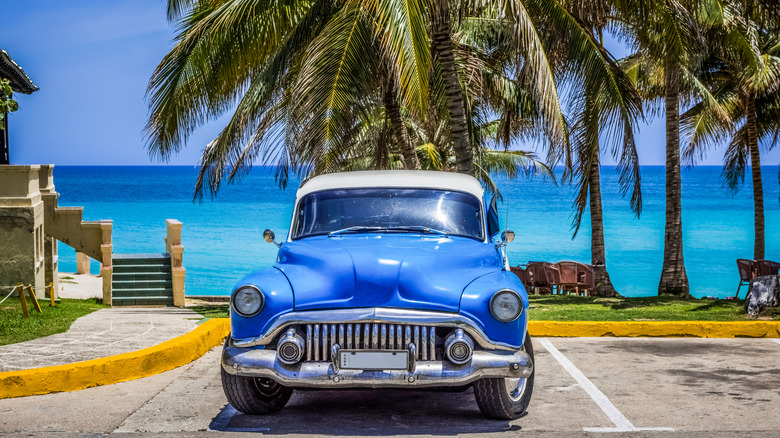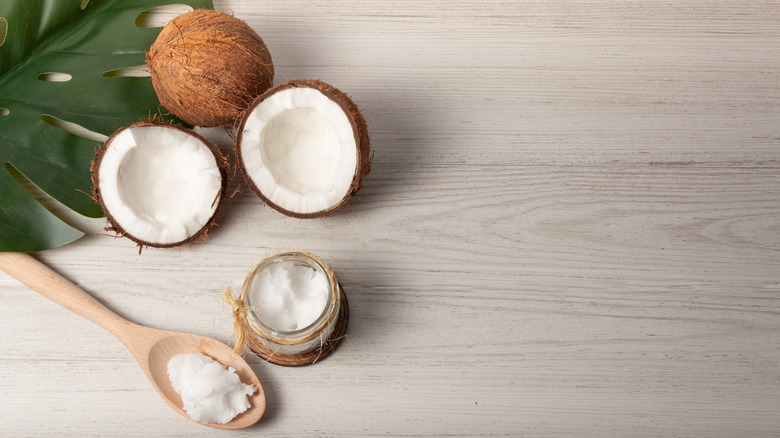The History Of How The Classic Piña Colada Cocktail Got Its Name
Sing it with me, loud and proud and at the top of your lungs: "If you like piña colada, and getting caught in the rain." Rupert Holmes' classic 1979 guilty pleasure song about infidelity in a relationship is not the first song to mention a cocktail by name (for example, the Eagles' "Tequila Sunrise" predates it by six years), but it certainly has one of the catchiest hooks of any such song.
The song is, of course, about a drink. According to Songfacts, Holmes was inspired to write about the drink after ruminating for a bit on what a couple would do on a romantic escape. Holmes concluded that the couple would first enjoy an adult beverage, and "Escape (The Piña Colada Song)" was born.
The fruity tropical beverage predates Holmes by a decade or two, depending on your point of view. These days, it joins the Mai Tai, the Daquiri, and other sweet and fruit-forward cocktails that not all mixologists take seriously.
What even is a piña colada?
The cool thing about mixology is that, as in the case of cuisine, the recipe is only a starting point. A purist may argue that a martini can only contain gin and vermouth, and in the proper proportions (and in some cases, with only specific brands of the liquors contained in the recipe), but a skilled mixologist can elevate the drink to something unexpected, while still retaining the basic structure of the cocktail. What's more, if you're in a place where taking cocktails to visually-appealing extremes is the norm, such as on a cruise ship or in a specialty lounge, your drink may be frozen, or have additional ingredients not in the original recipe (such as juices or extra liquors).
The piña colada is, at its most basic level, comprised of three ingredients, according to Mix That Drink: one part white rum, one part coconut cream and three parts pineapple juice — the phrase "piña colada" is Spanish for "strained pineapple." Of course, that's just the general structure of the drink, and it's not unlikely that the drink you order may be some variation of that recipe, to the point that it may even be unrecognizable to the original inventor.
It was definitely invented in Puerto Rico
The piña colada was invented in Puerto Rico, according to Forbes. Specifically, bartender Ramón "Monchito" Marrero whipped up the concoction in 1954 while working at the Caribe Hilton in San Juan. Marrero would be associated with the beverage for the next three and a half decades, and in 1978, Puerto Rico named the drink its official beverage. A few decades later, in 2004, Puerto Rico's then-Governor Sila María Calderón presented Marrero with a proclamation honoring the 50th anniversary of the drink.
Marrero said that he was inspired to make the drink after noticing that tourists took to the beaches early in the day. He wanted to provide them with something to drink that wouldn't get them hammered well before the sun set. "It is natural to hold a glass and sip something cool while enjoying this tropical setting, but before long, most folks start to feel the effects of their drinks and the rest of the day is ruined for them," he said, via The Washington Post.
The actual inventor is in dispute
That's not the end of the story, however. Two other men, according to Difford's Guide, also claim to have invented the piña colada. Ricardo Garcia, who worked at the same hotel, also claimed to have invented the drink. Further, Don Ramon Portas Mingot also claims to have invented the drink – 1963, nearly a decade after Marrero supposedly did. The whole thing was the source of quite a bit of controversy on the island, according to The Washington Post, with Marrera steadfastly insisting that it was he, and only he, invented the drink.
For whatever it's worth, Simon Difford, writing in Difford's Guide, says that it's quite possible all three men played a role in the invention of the piña colada, building on each other's work and tweaking the recipe as needed. What's known for certain is that the recipe for a piña colada didn't start appearing in cocktail recipe books until the 1960s, right around the time that Mingot supposedly invented it, and about a decade after Marrera claimed to have invented it.
It may have been invented in Cuba
In fact, the key ingredients of a piña colada – rum, coconut products, and pineapple juice – have been around for centuries. Rum was first distilled in 1650, according to Britannica, and coconut cream and pineapple juice have been around as long as coconuts and pineapples. It's likely that between 1650 and 1954, someone mixed those three things together, though whoever it was failed to write it down.
What's more, the Cubans had a piña colada-adjacent drink in the 1920s, named "piña colada." As Difford's Guide explains, the Cuban drink consisted of Bacardi rum, pineapple juice, lime, and sugar (no coconut products). "So the Puerto Ricans merely added cream of coconut and it is commonly accepted that the modern piña colada was adapted from an existing creation," Simon Difford writes.
commercial cream of coconut changed everything
As you just read, the difference between the Cuban piña colada and the Puerto Rican one (the version most of us think of) is the addition of coconut — specifically, cream of coconut. While humans have been using coconuts and coconut-derived products for tens of thousands of years, the product used in the delicious tropical beverage we all know and love didn't come about until the 1950s. Specifically, Simon Difford writes in Difford's Guide that it was the ready availability of Coco Lopez Cream of Coconut in those days that helped spur the creation of the modern beverage.
Don Ramon Lopez Irizarry, according to his company's website, enjoyed coconut cream as much as any other person who lived in the tropics, but getting it was a tedious and time-consuming process that had to be done at a specific time in the coconut seed's life. Lopez created a process that recreates the cream mechanically. Mass produced, cheap, and readily available, the new beverage not only simplified the process of making coconut-based food dishes, it also ushered in the creation of one of the world's most popular "guilty pleasure" beverages.
